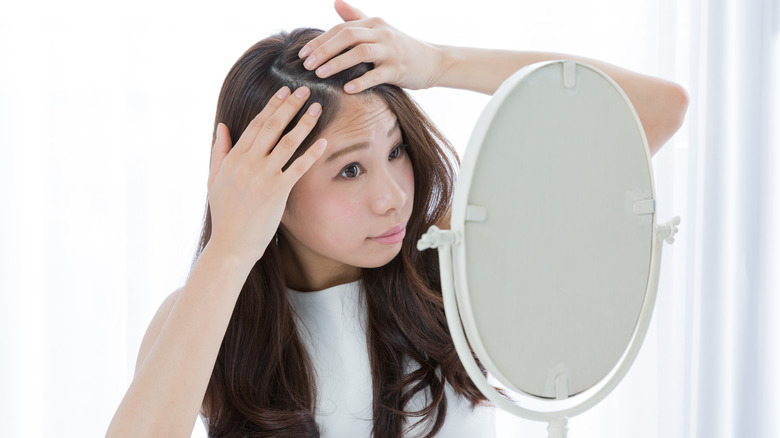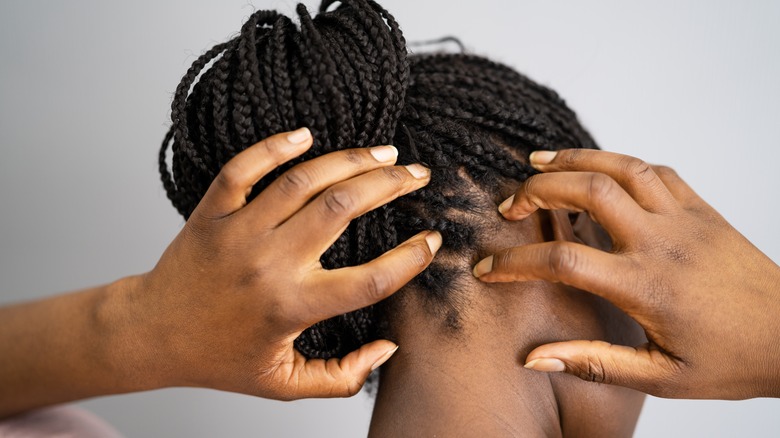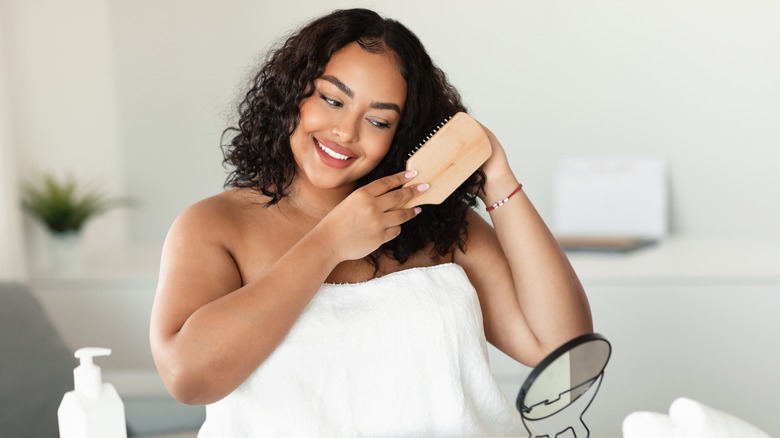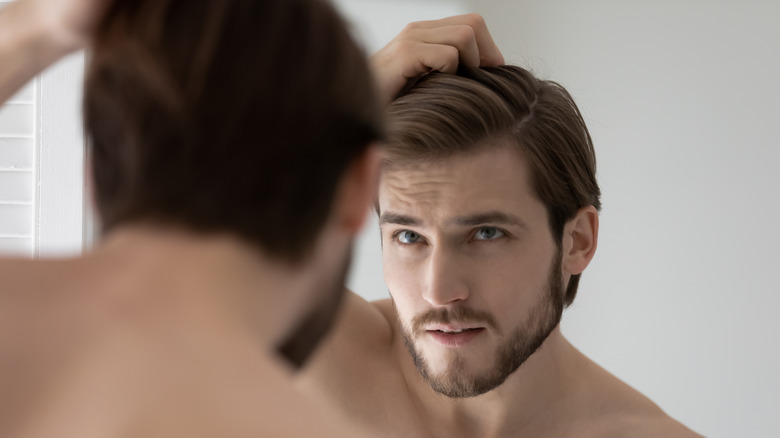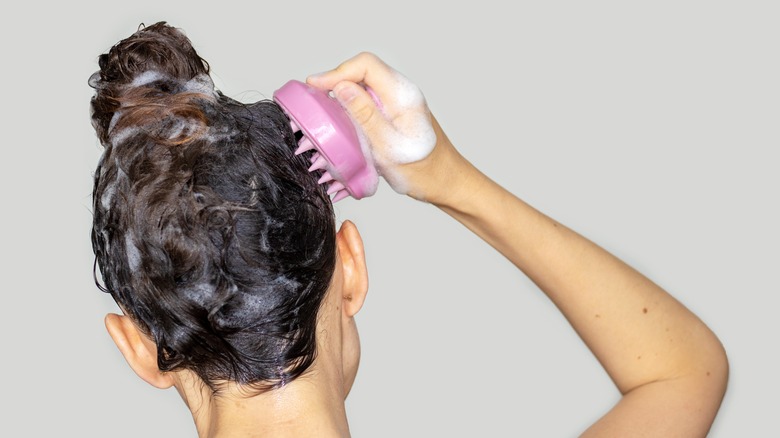The Four Phases Of Hair Growth Explained
Our hair is an important part of our identity, so it's crucial to be aware of what's going on during the natural cycle of regrowth. Thinning or brittle hair can be quite frustrating, and excessive hair falling out can also cause increased anxiety. This is why awareness about the hair-growth cycle, and learning some key ways to stimulate hair growth, can offer a sense of security should you notice any changes to your locks.
It's important to have an understanding of how your hair grows so that you can develop a healthy haircare routine to optimize the regrowth cycle. Of course, genetics do influence hair growth, but there are other circumstances that can impact how your hair does at each of the four phases of hair growth. Each phase has a unique timeline, which is influenced by factors such as age, hormones, overall health, lifestyle choices, and environment. The good news is that we know a lot about what to expect at each phase of hair growth, and how to best care for our hair during each of these phases.
The growing phase
The growing phase, also known as the antigen phase, is the first of the four growth phases. Mamina Turegano, a board-certified dermatologist, tells Harper's Bazaar, "The antigen phase is when the follicle is in the process of producing hair, and the stage in which most of your hairs currently exist." She goes on to say that this phase usually lasts about three to five years, with some people staying here for up to seven years if they have the genetics for it. On average, about 90 percent of our hair is currently in the antigen phase.
During this active growth, certain factors can influence how our hair does. According to Verywell Health, a condition that causes hair to thin in the antigen phase is called telogen effluvium. This causes noticeably thinner hair for certain individuals, due to acceleration through the antigen phase — doubling and tripling normal hair loss. Some of the main causes for this condition include high fevers from illness, childbirth, surgery, emotional stress, poor nutrition, significant weight loss, and certain medications.
Regression, resting and shedding
The regression phase, also known as the catagen phase, is where the follicle starts to shrink at the base and separate. This phase usually only lasts about seven to 10 days (via Harper's Bazaar). At this phase, our follicle is not yet ready to shed the hair, but is preparing for the next phase.
The third phase is the resting phase, also known as the telogen phase. While here, our hair is in an inactive stage that lasts about three to five months. The strand is not growing anymore and ready to fall out.
The last phase is known as the shedding, or exogen phase. During this time, hairs fall out, often helped by washing or brushing. New hairs are growing in the follicle as the old hair sheds away. On average, we lose 50 to 100 strands of hair per day. This is also when people might notice excessive hair loss, or see an increase in hair shedding because of telogen effluvium. If you feel like you're suddenly losing hair for no reason, think back three to five months to find potential causes.
Factors that affect hair growth
As mentioned above, there are a number of factors that affect the regrowth of hair. Sometimes the factors are beyond our control such as genetics, illness, and hormone fluctuation. However, there are many lifestyle choices that have an impact on the health of hair. One of the most important manageable factors to healthy hair is diet and nutrition. As Healthline explains, our hair is largely made of protein, so including lean meats, fish, legumes, and beans in our diet can positively affect hair growth.
A 2019 study from the Journal of Dermatology and Therapy found that supplemental intake of vitamin D, vitamin C, and iron was associated with healthy hair growth. Researchers also found a correlation between healthy hair growth and biotin, vitamin B12, folic acid, and zinc. Beyond vitamin deficiencies, other factors that can slow hair growth include dust and smoke exposure, stress, crash diets, eating disorders, and not using the correct shampoo and conditioner for your hair.
The effect stress has on hair growth
While there are many hair myths we need to stop believing, stress is one real factor that affects hair growth. High levels of stress can cause our hair to fall out faster than normal. According to Mayo Clinic, there are three types of hair loss conditions that are associated with high stress levels. As mentioned above, telogen effluvium is a condition that pushes the hair follicles into the resting phase, sometimes caused by a significant amount of stress. Another condition, trichotillomania, is a stress-related condition where a person has the urge to pull the hair at the scalp as a way of dealing with negative feelings. The third hair-loss condition that has been correlated to stress is alopecia. With alopecia, the body's immune system attacks the hair follicles, which causes significant hair loss.
Sudden or patchy hair loss can be a sign of an underlying medical condition, so always talk to your doctor should you notice any hair changes. To prevent stress-related hair loss, consider ways to find balance in your life so that you are able to manage stress easier. Getting a good night's sleep, eating a healthy diet, getting enough exercise, and even seeing a therapist are all good ways to decrease stress levels. Yoga, meditation, and breathing techniques can help to reduce stress and promote new hair growth.
Tips for a healthy scalp
A healthy scalp means healthy hair during each of the growth cycles. So, how do we know if we have a healthy scalp in the first place? Dr. Sanusi Umar, medical director and dermatologist, informs Healthline that a healthy scalp is free of itchiness, redness, flakiness, irritation, pain, acne, cysts, sun damage, and excessive hair loss. If you have any of these conditions, you may want to consider ways to improve your scalp health so that your hair can thrive during the growth cycles.
Getting a healthy scalp starts with using gentle hair care products, and avoiding products containing harsh chemicals. Because the skin on our scalp is already sensitive, avoiding sulfates, alcohols, and fragrances can improve scalp health. Massaging the scalp when shampooing is another way to increase circulation to the follicles. Avoid washing your hair too frequently, which can strip the scalp of natural oils. Umar suggests washing three to four times per week, at most. Finally, finding a good scalp scrub to use as an exfoliator can potentially help boost hair growth.
